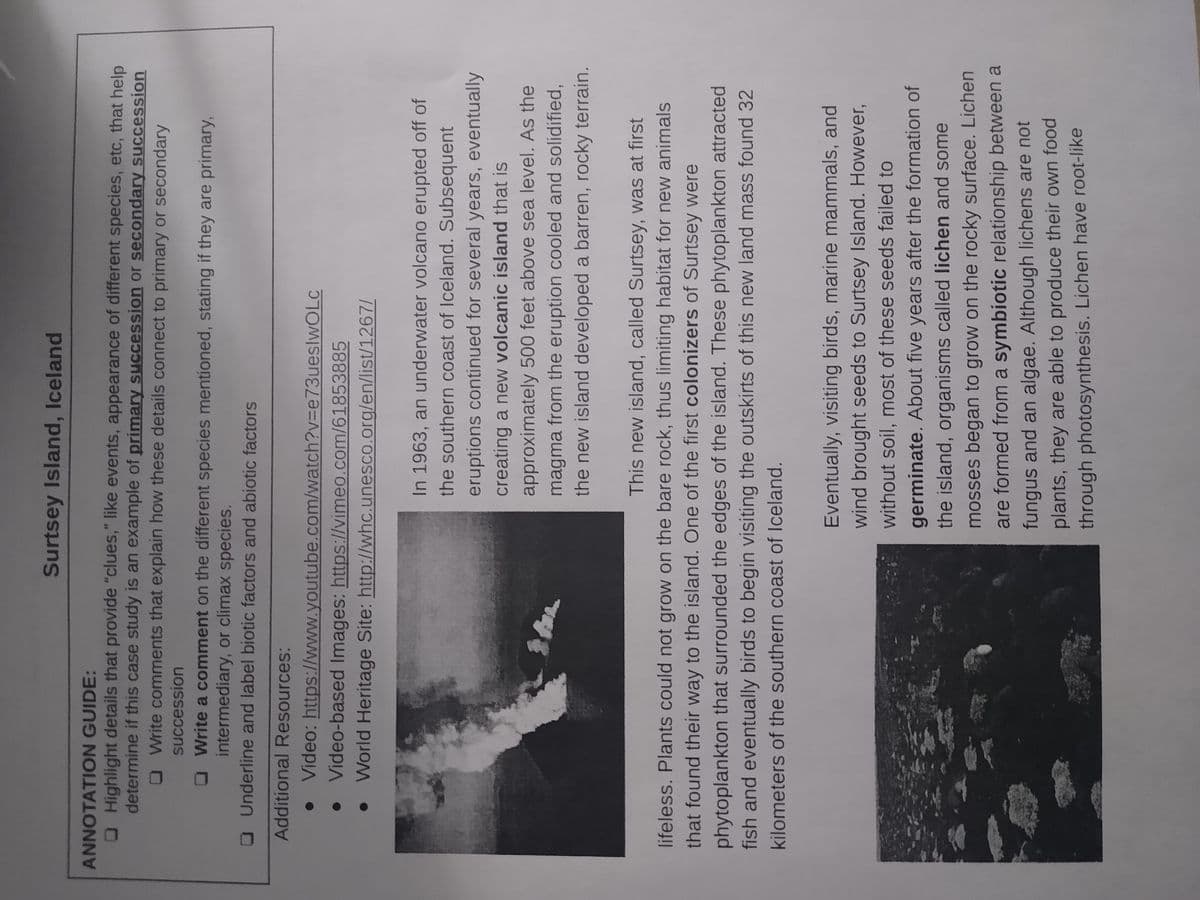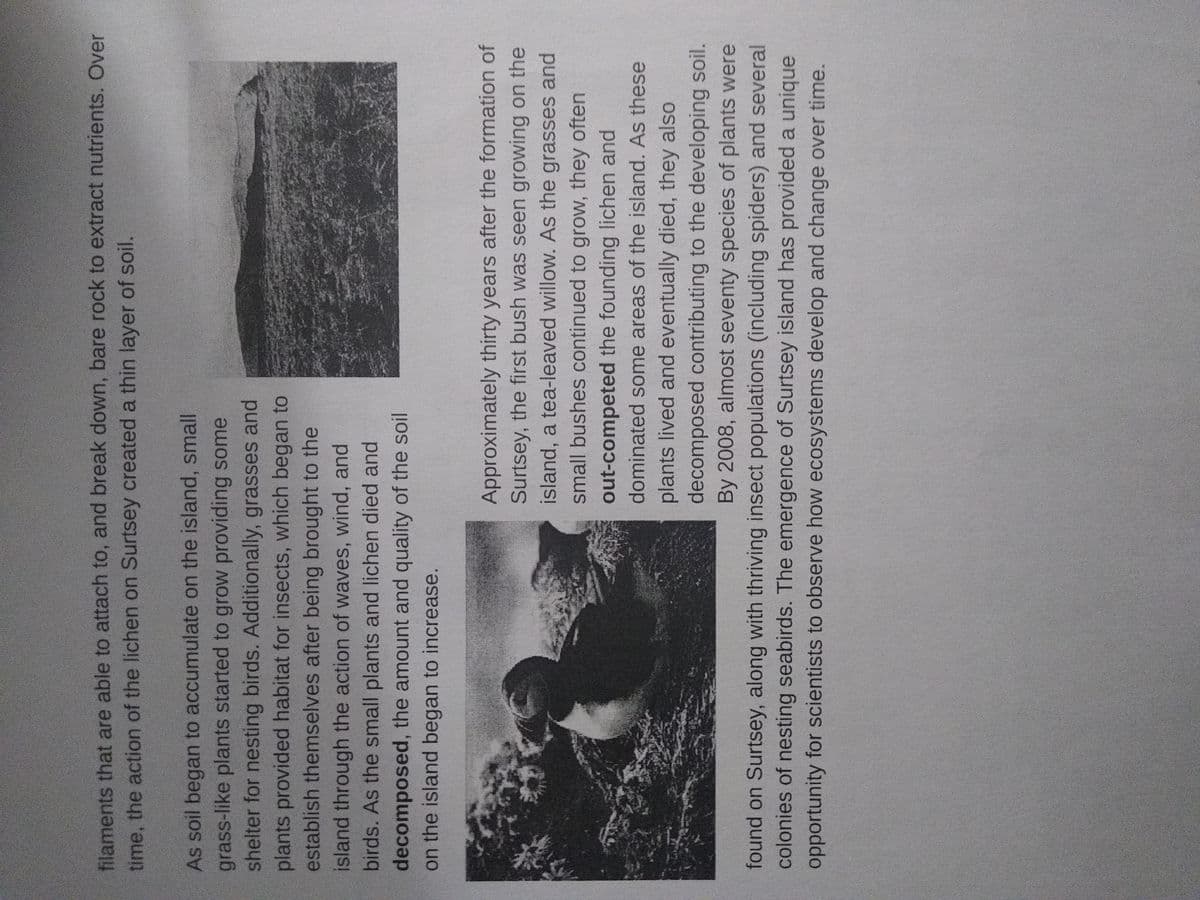Biology (MindTap Course List)
11th Edition
ISBN:9781337392938
Author:Eldra Solomon, Charles Martin, Diana W. Martin, Linda R. Berg
Publisher:Eldra Solomon, Charles Martin, Diana W. Martin, Linda R. Berg
Chapter55: Ecosystems And The Biosphere
Section55.4: Studying Ecosystem Processes
Problem 9LO: Briefly describe some of the long-term ecological research conducted at Hubbard Brook Experimental...
Related questions
Question
100%
In Surtsey Island, Iceland, how are biotic factors causing changes in abiotic factors?

Transcribed Image Text:Surtsey Island, Iceland
ANNOTATION GUIDE:
Highlight details that provide "clues," like events, appearance of different species, etc, that help
determine if this case study is an example of primary succession or secondary succession
Write comments that explain how these details connect to primary or secondary
succession
Write a comment on the different species mentioned, stating if they are primary,
intermediary, or climax species.
Underline and label biotic factors and abiotic factors
Additional Resources:
Video: https://www.youtube.com/watch?v=e73ueslwOLc
Video-based Images: https://vimeo.com/61853885
World Heritage Site: http://whc.unesco.org/en/list/1267/
In 1963, an underwater volcano erupted off of
the southern coast of Iceland. Subsequent
eruptions continued for several years, eventually
creating a new volcanic island that is
approximately 500 feet above sea level. As the
magma from the eruption cooled and solidified,
the new island developed a barren, rocky terrain.
This new island, called Surtsey, was at first
lifeless. Plants could not grow on the bare rock, thus limiting habitat for new animals
that found their way to the island. One of the first colonizers of Surtsey were
phytoplankton that surrounded the edges of the island. These phytoplankton attracted
fish and eventually birds to begin visiting the outskirts of this new land mass found 32
kilometers of the southern coast of Iceland.
Eventually, visiting birds, marine mammals, and
wind brought seeds to Surtsey Island. However,
without soil, most of these seeds failed to
germinate. About five years after the formation of
the island, organisms called lichen and some
mosses began to grow on the rocky surface. Lichen
are formed from a symbiotic relationship between a
fungus and an algae. Although lichens are not
plants, they are able to produce their own food
through photosynthesis. Lichen have root-like

Transcribed Image Text:filaments that are able to attach to, and break down, bare rock to extract nutrients. Over
time, the action of the lichen on Surtsey created a thin layer of soil.
As soil began to accumulate on the island, small
grass-like plants started to grow providing some
shelter for nesting birds. Additionally, grasses and
plants provided habitat for insects, which began to
establish themselves after being brought to the
island through the action of waves, wind, and
birds. As the small plants and lichen died and
decomposed, the amount and quality of the soil
on the island began to increase.
Approximately thirty years after the formation of
Surtsey, the first bush was seen growing on the
island, a tea-leaved willow. As the grasses and
small bushes continued to grow, they often
out-competed the founding lichen and
dominated some areas of the island. As these
plants lived and eventually died, they also
decomposed contributing to the developing soil.
By 2008, almost seventy species of plants were
found on Surtsey, along with thriving insect populations (including spiders) and several
colonies of nesting seabirds. The emergence of Surtsey island has provided a unique
opportunity for scientists to observe how ecosystems develop and change over time.
Expert Solution
This question has been solved!
Explore an expertly crafted, step-by-step solution for a thorough understanding of key concepts.
This is a popular solution!
Trending now
This is a popular solution!
Step by step
Solved in 2 steps

Knowledge Booster
Learn more about
Need a deep-dive on the concept behind this application? Look no further. Learn more about this topic, biology and related others by exploring similar questions and additional content below.Recommended textbooks for you

Biology (MindTap Course List)
Biology
ISBN:
9781337392938
Author:
Eldra Solomon, Charles Martin, Diana W. Martin, Linda R. Berg
Publisher:
Cengage Learning

Biology (MindTap Course List)
Biology
ISBN:
9781337392938
Author:
Eldra Solomon, Charles Martin, Diana W. Martin, Linda R. Berg
Publisher:
Cengage Learning